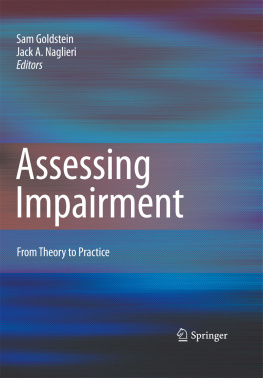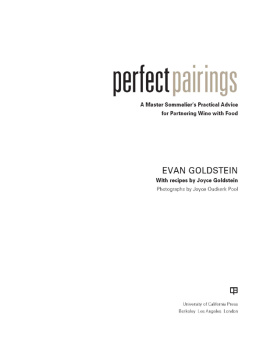Goldstein Sam - Assessing impairment from theory to practice
Here you can read online Goldstein Sam - Assessing impairment from theory to practice full text of the book (entire story) in english for free. Download pdf and epub, get meaning, cover and reviews about this ebook. City: Boston;MA;États-Unis;New York;NY, year: 2009, publisher: Springer US, genre: Home and family. Description of the work, (preface) as well as reviews are available. Best literature library LitArk.com created for fans of good reading and offers a wide selection of genres:
Romance novel
Science fiction
Adventure
Detective
Science
History
Home and family
Prose
Art
Politics
Computer
Non-fiction
Religion
Business
Children
Humor
Choose a favorite category and find really read worthwhile books. Enjoy immersion in the world of imagination, feel the emotions of the characters or learn something new for yourself, make an fascinating discovery.
- Book:Assessing impairment from theory to practice
- Author:
- Publisher:Springer US
- Genre:
- Year:2009
- City:Boston;MA;États-Unis;New York;NY
- Rating:4 / 5
- Favourites:Add to favourites
- Your mark:
- 80
- 1
- 2
- 3
- 4
- 5
Assessing impairment from theory to practice: summary, description and annotation
We offer to read an annotation, description, summary or preface (depends on what the author of the book "Assessing impairment from theory to practice" wrote himself). If you haven't found the necessary information about the book — write in the comments, we will try to find it.
Assessing impairment from theory to practice — read online for free the complete book (whole text) full work
Below is the text of the book, divided by pages. System saving the place of the last page read, allows you to conveniently read the book "Assessing impairment from theory to practice" online for free, without having to search again every time where you left off. Put a bookmark, and you can go to the page where you finished reading at any time.
Font size:
Interval:
Bookmark:
Sam Goldstein1  and Jack Naglieri
and Jack Naglieri
| (1) | University of Utah School of Medicine, Salt Lake City, UT, USA |
| (2) | George Mason University, Centerville, VA, USA |
In Western medicine, the medical model guides diagnosis and treatment in all aspects of medicine and mental health. The purpose is to identify treatments for diagnoses based on evidence of specific symptoms assumed to suggest problems inherent within one or more organs of the human body. The medical model has driven research and theory about physical and mental health problems on the basis of causation, symptom relief, and cure and in some cases has been quite successful (e.g., tuberculosis, measles, etc.). As the fields of medicine and psychology have evolved, interest in the degree of impairment, regardless of the diagnosis, has increased.
Until very recently, functional impairment has not been a major focus in diagnosis or treatment in either physical or mental health problems. This interest has been sparked by an emerging body of literature that has suggested that symptoms and functional impairment need to be considered separately in making diagnostic decisions and evaluating treatment response (Bird et al., ), it is not unexpected that there is an increasing need to demonstrate functional impairment as part of the diagnostic process. In addition, in this volume a foundation is given to further appreciate why understanding impairment is by far the most important and greatest challenge facing medical, educational, and mental health care providers today. This assumes, of course, that impairment can be defined.
Key term | Definition |
Impair | To weaken or damage |
Impaired | To be unable to perform whatever daily activities are required |
Impairment | The state or fact of being impaired |
Symptoms | A physical or mental feature regarded as indicating a condition of disease; a sign of the existence of something of an undesirable situation |
Disability | A physical or mental condition that limits a person's movements; a disadvantage or handicap; with respect to an individual, a physical or mental impairment that substantially limits one or more of the major life activities of such individual, a record of such an impairment, or being regarded as having such an impairment (Individuals with Disabilities Improvement Act [IDEA], 2004) |
Disabled | Having a physical or mental condition that limits a person's movements, senses or activities |
Injury | The fact of being injured, harmed, or damaged |
Injured | To suffer physical harm or damage of one's body |
Adaptive | Making something suitable for a new use or purpose; modifying to a new condition |
Adaptive behavior | A type of behavior that is used to adapt to another type of behavior or situation |
Condition | Definition |
Mental health | The consequences that ensue for an individual as a result of symptoms (Barkley et al., 2006) |
Medical | A significant deviation loss or loss of use of any body, structure, or function in an individual with a health condition disorder or disease (International Classification of Diseases [ICD] (2007)) |
Mental retardation | Limited intellectual ability and adaptive behavior as expressed in conceptual, social, and practical skills (American Association on Intellectual and Developmental Disabilities [AIDD], 2008) |
Educational | A discrepancy between actual and expected performance |
Resilience | Lack of capacity to function effectively in the face of adversity |
We can take a simple example of a child's activity level to illustrate these differences. A parent is asked to evaluate whether he or she believes his or her child is overactive. The parent endorses a high level of activity. This represents a symptom. In and of itself, it does not necessarily speak to any level of impairment. The parent is then asked whether the child's excessive activity level causes problems and, if so, in what situations? The parent endorses the dinner table as a source of problems. At this point, we know that the symptom presents in a specific situation to a significant degree. The level of impairment is still unknown. The parent is then asked whether the child is capable in any situation of sitting still, and the parent responds affirmatively. The parent notes, however, that at the dinner table the child does not sit still. The parent is further asked if the child knows how to properly use dinner utensils and feed him- or herself. The parent again responds affirmatively. At this point, it is clear that the child possesses adaptive skills. That is, the child knows what to do but, as the parent describes, is not doing what he or she knows. This represents a failure to exhibit adaptive behavior but in and of itself is still short of providing the needed information about functional impairment. The parent is then asked to describe what takes place during dinner. Because of the child's symptom severity, an insufficient number of calories is consumed, and food is spilled. This phenomenon represents the impairment caused by this child's hyperactive behavior.
Font size:
Interval:
Bookmark:
Similar books «Assessing impairment from theory to practice»
Look at similar books to Assessing impairment from theory to practice. We have selected literature similar in name and meaning in the hope of providing readers with more options to find new, interesting, not yet read works.
Discussion, reviews of the book Assessing impairment from theory to practice and just readers' own opinions. Leave your comments, write what you think about the work, its meaning or the main characters. Specify what exactly you liked and what you didn't like, and why you think so.












